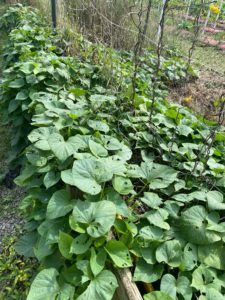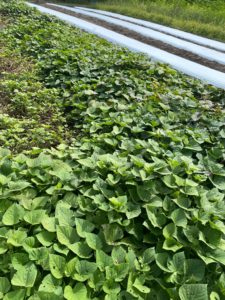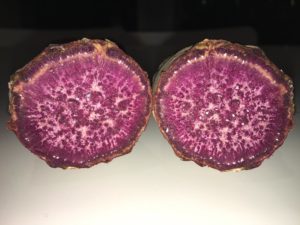Sweet potatoes were commonly grown in the southeastern United States for a long time, and have become popular throughout the US. They were first cultivated in South and Central America. The sweet potato first spread to Polynesia as early as 1,000 B.C., long before Western colonization. The most popular kind of sweet potatoes in the US are the orange varieties, though purple, yellow, and white sweet potatoes are also favorites. They can be prepared for the table in a huge variety of ways.
throughout the US. They were first cultivated in South and Central America. The sweet potato first spread to Polynesia as early as 1,000 B.C., long before Western colonization. The most popular kind of sweet potatoes in the US are the orange varieties, though purple, yellow, and white sweet potatoes are also favorites. They can be prepared for the table in a huge variety of ways.
Sweet Potato Varieties
Beauregard, Georgia Jet, and Jewel sweet potatoes, the most common varieties of the familiar orange ones, are sweet, can be mashed, and are great all-purpose veggies. There are also several types of yellow and white sweet potatoes. These are dense and firm and are good for sweet potato fries or for roasting. Purple sweet potatoes are commonly either Stokes or Okinawa. Stokes have purple skin and flesh, and Okinawa has white skin and deep purple flesh. These are usually roasted. All can be used as sweet potatoes in different recipes, but the firmer ones usually require longer cooking times.
These tubers are a great source of vitamins A and C and are a pretty good source of potassium and Vitamin B6. They also have some iron and magnesium. They are rich in antioxidants and also high in fiber. Basically, sweet potatoes are a great source of nutrition for the entire family!

Planting Information
- Sweet Potato: Ipomoea batatas
- Perennial (usually grown as an annual)
- Full sun (8-10 hours a day)
- Soil should be slightly acidic (5.5-6.5 pH)
- Well-drained, fertile sandy soil (very sandy to a slightly sandy loam).
- Clay soil, though not preferred, will work. Some varieties, like the Jewel Sweet Potato (an orange variety) will do very well.
- Garden planting:
Use sweet potato “slips,” either grown from tubers or purchased
Plant slips at least 18” apart.
Rows should be 30” apart.
- Climate Zones 6-12
- Container planting:
Start slips in seedling pots, transplant to large 20-30 gallon containers
4-5 plants per container is OK.
How to Grow Sweet Potatoes
 Sweet potatoes take a long time to mature but are easy to grow. The first step is to prepare the tubers for garden planting. Starting about 30 days before the last frost, take several sweet potato tubers, set them in a container of potting soil, lying the tuber down sideways, with the soil half covering the tuber. Keep the pot in full sun (4 hours a day minimum, more is better) or under a grow light for several weeks, watching for “slips” to start growing. These slips are the buds and stems that will grow from the tubers. Roots will also grow from under the tuber. Wait until the slips are 4-6 inches tall, and clip them off. Starting about 4 weeks after the last frost, plant the slips in the garden about 18 inches apart. In warmer climates, let the rootless slips grow in vermiculite for about a week, then transplant. Slips that have attached roots are perfect, but buds with slips growing from the main tuber are also fine even without roots. If you have enough, you can plant multiple rows. Mulch the plants to help keep the soil warm. Keep them watered, at ground level, on a regular basis. In warmer climates, I suggest growing the rootless slips in vermiculite for about a week, then transplant.
Sweet potatoes take a long time to mature but are easy to grow. The first step is to prepare the tubers for garden planting. Starting about 30 days before the last frost, take several sweet potato tubers, set them in a container of potting soil, lying the tuber down sideways, with the soil half covering the tuber. Keep the pot in full sun (4 hours a day minimum, more is better) or under a grow light for several weeks, watching for “slips” to start growing. These slips are the buds and stems that will grow from the tubers. Roots will also grow from under the tuber. Wait until the slips are 4-6 inches tall, and clip them off. Starting about 4 weeks after the last frost, plant the slips in the garden about 18 inches apart. In warmer climates, let the rootless slips grow in vermiculite for about a week, then transplant. Slips that have attached roots are perfect, but buds with slips growing from the main tuber are also fine even without roots. If you have enough, you can plant multiple rows. Mulch the plants to help keep the soil warm. Keep them watered, at ground level, on a regular basis. In warmer climates, I suggest growing the rootless slips in vermiculite for about a week, then transplant.
Temperature
Sweet potatoes are a warm-weather plant. They need a minimum of 60°F, preferably warmer for both soil and air. They prefer between 65°F and 85°F, for the soil temperature, and even warmer for the outside air temperature, doing best from 70°F to as high as 100°F. For spring planting, it’s a good idea to prepare the garden bed early, and cover it with a sheet of black plastic (like from a trash bag) until you plant. This will warm up the soil faster. After planting, mulch with straw or wood chips, this will keep weeds down and keep the soil temperature more stable.

Sweet Potato Companion Planting
There are several plants that act to support and protect sweet potatoes. Aromatic herbs like dill, oregano, and thyme, as well as summer savory, will repel pests like the sweet potato weevil. Red clover will help with nutrition and can repel both aphids and wireworms. Root vegetables like beets and radishes will also do well with sweet potatoes and can help with flea beetles. Legumes like bush and pole beans and peas are also good companions. Pole beans are sometimes easier for this since a trellis will keep the bean vines separate from the sweet potato vines on the ground. If you are using companions, do be sure to give some space, as the sweet potato vines cover a large area.
Sweet Potato Pests and Diseases
In addition to sweet potato weevils, wireworms, flea beetles, and aphids, there are a few other pests that can be troublesome. Cucumber beetles, hornworms, armyworms, whiteflies, and thrips can all become an issue. Pests can also be treated with organic Neem Oil garden spray. This will kill pests and not harm beneficial insects. Cinnamon sprinkled around the base of the sweet potato slips will deter ants. The fungal diseases of leaf spot and fusarium rot are troublesome, and bacterial wilt is sometimes a problem. Crop rotation is absolutely the best prevention for both pests and disease. Planting in a new location will prevent the old pests from coming back the next year. Plant a winter cover crop in the fall like clover in the area where you will plant the next year. This will enrich the soil and help prevent pests.
Soil Fertility
 Ensure that the soil does not have too much nitrogen, as this will encourage leaf production but slow or even stop tubers from growing. If for some reason the sweet potato plants grow leaves in abundance, but produce small or no tubers, it’s likely the soil has too much nitrogen. Wood chip mulch, or even just sawdust, can help with drawing nitrogen from the soil while the plants grow. If it still happens, rotate the crops the following year and plant squash, cabbage, or broccoli in the previous sweet potato patch. This will use up the nitrogen. These plants will not be a great harvest, also due to the high nitrogen, but they will draw it from the soil, and that patch should be good the year after. These are not good companion plants since they will all compete for resources with the Sweet Potatoes, so don’t plant them together!
Ensure that the soil does not have too much nitrogen, as this will encourage leaf production but slow or even stop tubers from growing. If for some reason the sweet potato plants grow leaves in abundance, but produce small or no tubers, it’s likely the soil has too much nitrogen. Wood chip mulch, or even just sawdust, can help with drawing nitrogen from the soil while the plants grow. If it still happens, rotate the crops the following year and plant squash, cabbage, or broccoli in the previous sweet potato patch. This will use up the nitrogen. These plants will not be a great harvest, also due to the high nitrogen, but they will draw it from the soil, and that patch should be good the year after. These are not good companion plants since they will all compete for resources with the Sweet Potatoes, so don’t plant them together!
Harvesting Sweet Potatoes
Once the sweet potatoes are 3-4 months along when the leaves start to turn yellow they will be ready to harvest. Try to get them harvested before the first frost in the fall. If the weather surprises you, it’s OK to harvest just after the first frost but don’t delay after that. Dig the tubers out gently, they are somewhat delicate. Brush off the majority of the dirt, but don’t wash them at first. Dry them in a warm location for a week or two. This “curing” allows the tuber to get sweeter as it dries fully. They can then be stored in the refrigerator for a long time, even up to six months. Sweet potato gardening is a long process but it’s not complicated, and it’s very rewarding. The slips each produce three of four full-sized sweet potatoes in temperate zones, and even more in warmer areas! Get started with Hortisketch. Plan your garden today!


Contact Author
 Info@gardensavvy.com
Info@gardensavvy.com Recent Posts
- Smart Gardening: How Technology Is Revolutionizing Horticulture
- Understanding Gardening Zones: What You Need to Know
- The Right Tools For Your Gardening And Landscaping Needs
- Maximizing Your Harvest: Square Foot Gardening Chart for Beginners
- Holiday Garden Scents: Plants for Natural Aromatherapy in Your Home









